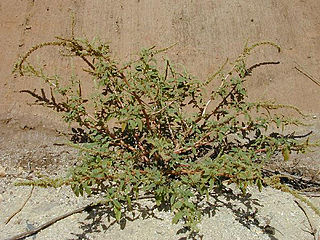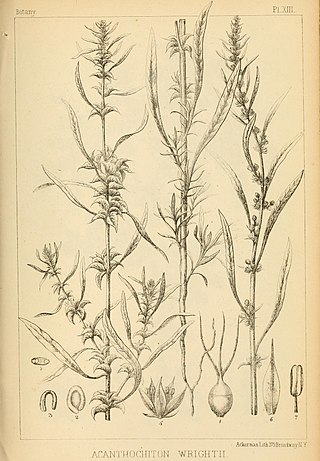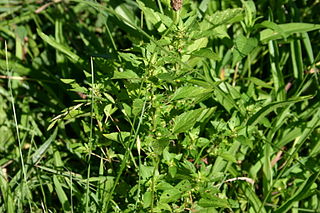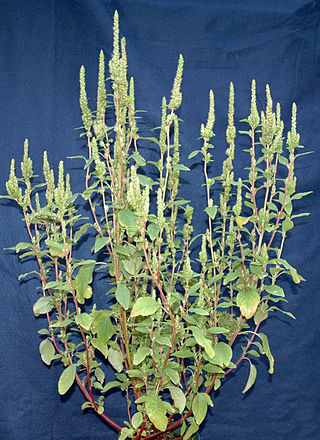
Amaranthus is a cosmopolitan group of more than 50 species which make up the genus of annual or short-lived perennial plants collectively known as amaranths. Some of the better known names include "prostrate pigweed" and "love lies bleeding". Some amaranth species are cultivated as leaf vegetables, pseudocereals, and ornamental plants.

Amaranthus hypochondriacus is an ornamental plant commonly known as Prince-of-Wales feather or prince's-feather. Originally endemic to Mexico, it is called quelite, bledo and quintonil in Spanish.

Amaranthus spinosus, commonly known as the spiny amaranth, spiny pigweed, prickly amaranth or thorny amaranth, is a plant that is native to the tropical Americas, but is present on most continents as an introduced species and sometimes a noxious weed. It can be a serious weed of rice cultivation in Asia.

Amaranthus retroflexus is a species of flowering plant in the family Amaranthaceae with several common names, including red-root amaranth, redroot pigweed, red-rooted pigweed, common amaranth, pigweed amaranth, and common tumbleweed.

Amaranthus fimbriatus is a species of glabrous flowering plant in the Amaranthaceae family. It is commonly known as fringed amaranth or fringed pigweed. The plant is an annual herb that can often grow up to 0.7 m (2 ft.) in height. The flower is greenish to maroon. It is found in North America and in Mexico. It often grows on sandy, gravelly slopes, semideserts or in disturbed habitats. It usually blooms after the summer rains in these arid regions. It is considered to be an invasive weed.

Tiarella, the foamflowers, is a genus of flowering plants in the family Saxifragaceae. The generic name Tiarella means "little turban", which suggests the shape of the seed capsules. Worldwide there are seven species, one each in eastern Asia and western North America, plus five species in eastern North America. As of October 2022, the taxonomy of Tiarella in eastern North America is in flux.

Amaranthus acanthochiton, the greenstripe, is an annual plant species of the genus Amaranthus in the family Amaranthaceae. It is native to the southwestern United States and northern Mexico (Chihuahua), growing at elevations of 1000–2000 m where it is uncommon.
Amaranthus australis is also known as southern amaranth or southern water-hemp. The plant usually grows from 1 to 3 m in height, though some have been known to grow up to 9 m (30 ft) high. The stems can be up to 30 cm in diameter. It is a herbaceous annual. It is found in many southern states of the United States, Mexico, the West Indies, and South America. They are frequently found in wetland areas. It is herbaceous, short lived perennial. The largest is 4.6 m (15 ft) tall.
Amaranthus bigelovii is a flowering plant commonly known as Bigelow's amaranth. It is an annual plant native to New Mexico, Texas, and Louisiana.
Amaranthus floridanus, the Florida amaranth, is a flowering plant endemic to Florida.

Monarda fistulosa, the wild bergamot or bee balm, is a wildflower in the mint family Lamiaceae, widespread and abundant as a native plant in much of North America. This plant, with showy summer-blooming pink to lavender flowers, is often used as a honey plant, medicinal plant, and garden ornamental. The species is quite variable, and several subspecies or varieties have been recognized within it. Despite its name, it has no relation to the 'true' bergamot, a citrus fruit.

Acalypha rhomboidea is a plant in the spurge family, Euphorbiaceae.

Amaranthus pumilus, the seaside amaranth or seabeach amaranth, is a species of amaranth. This annual plant is now a threatened species, although it was formerly scattered along the eastern coast of the United States, its native range.

Amaranthus powellii is a species of amaranth known by the common names Powell's amaranth and green amaranth.

Symphyotrichum pilosum is a perennial, herbaceous, flowering plant in the Asteraceae family native to central and eastern North America. It is commonly called hairy white oldfield aster, frost aster, white heath aster, heath aster, hairy aster, common old field aster, old field aster, awl aster, nailrod, and steelweed. There are two varieties: Symphyotrichumpilosum var.pilosum, known by the common names previously listed, and Symphyotrichumpilosum var.pringlei, known as Pringle's aster. Both varieties are conservationally secure globally and in most provinces and states where they are native.

Glossopetalon spinescens, syn. Forsellesia spinescens, is a species of flowering shrub in the family Crossosomataceae known by the common names greasebush, spiny greasebush, Nevada greasewood and spring greasebush.

Cirsium eatonii, commonly known as Eaton's thistle or mountaintop thistle, is a North American species of flowering plants in the family Asteraceae.

Symphyotrichum falcatum is a species of flowering plant in the family Asteraceae. Commonly called white prairie aster and western heath aster, it is native to a widespread area of central and western North America.

Symphyotrichum drummondii is a species of flowering plant of the family Asteraceae native to the central and eastern United States. The common name Drummond's aster has been used for the species. There also is an accepted variety native to the south-central United States and northeast Mexico named S. drummondiivar. texanum. This variety has the common name of Texas aster. The species is a perennial, herbaceous plant that may reach 120 centimeters in height.

Symphyotrichum spathulatum is a species of flowering plant in the family Asteraceae native to western North America including northwestern Mexico. Commonly known as western mountain aster, it is a perennial, herbaceous plant that may reach 20 to 80 centimeters tall. Its flowers, which open in July and August, have violet ray florets and yellow disk florets.

















